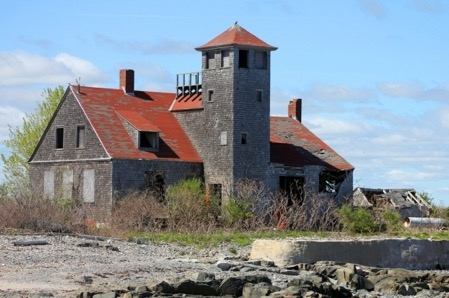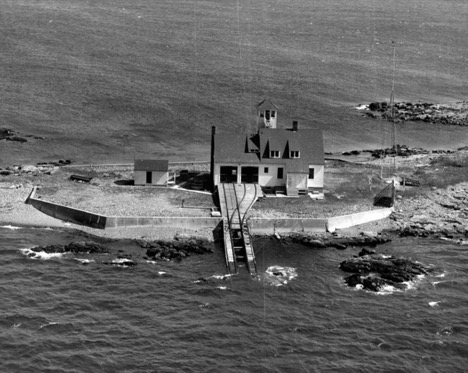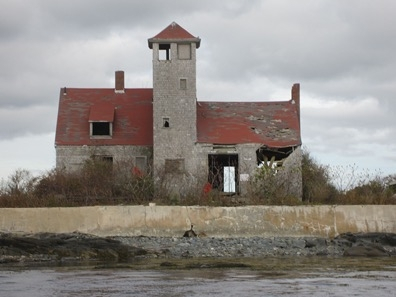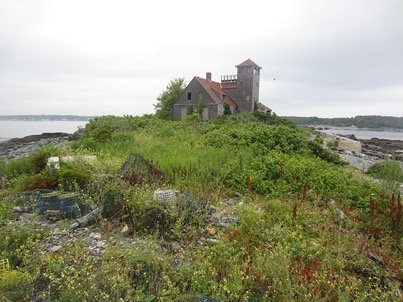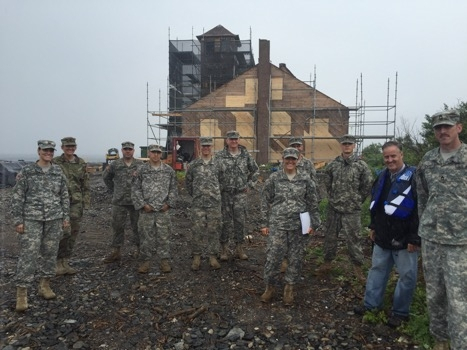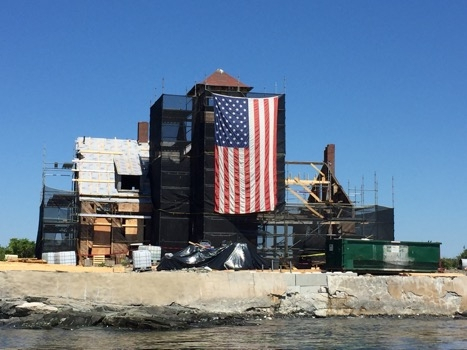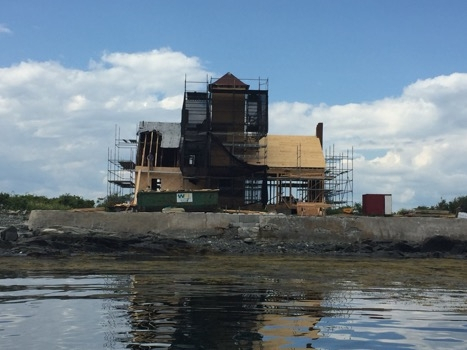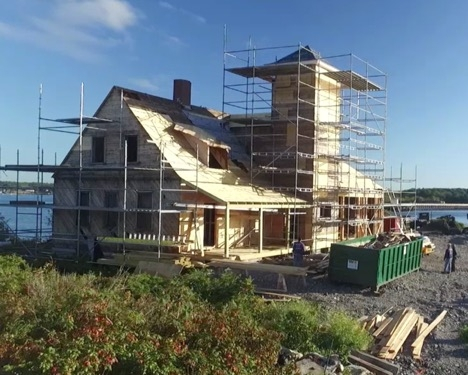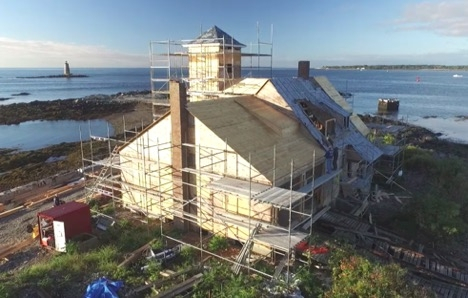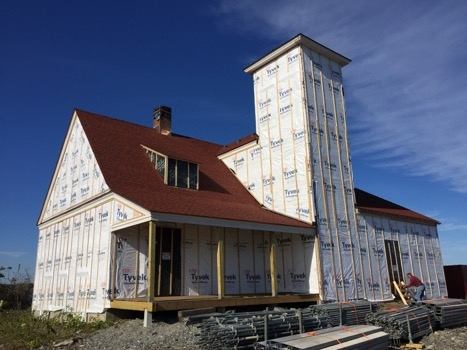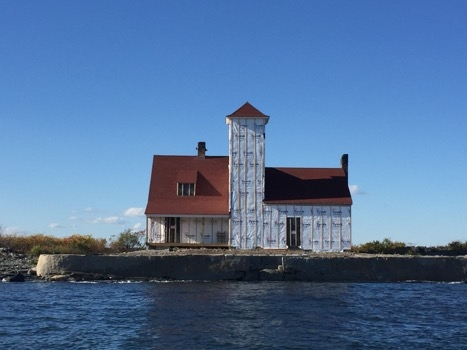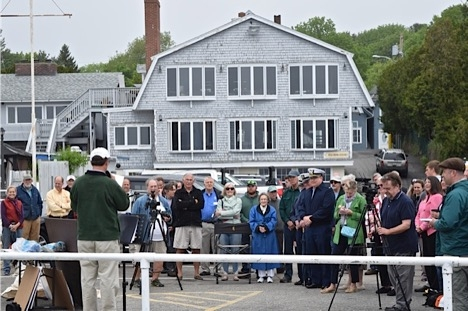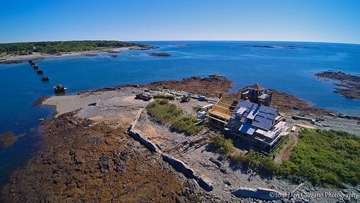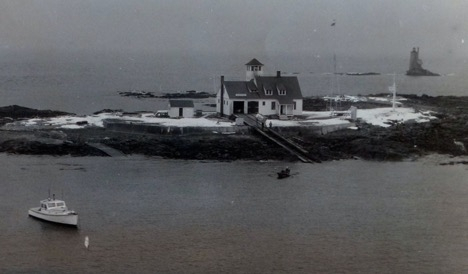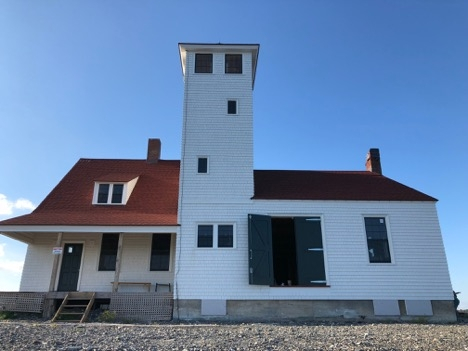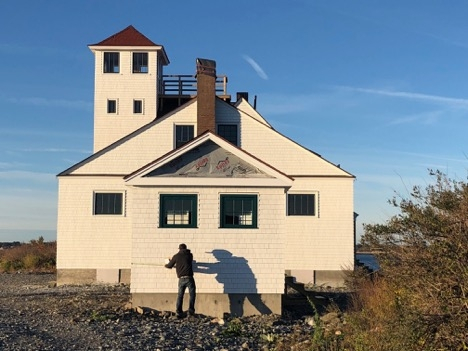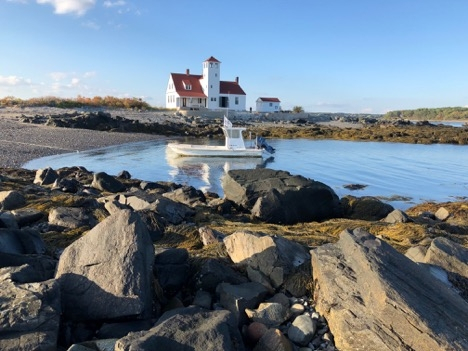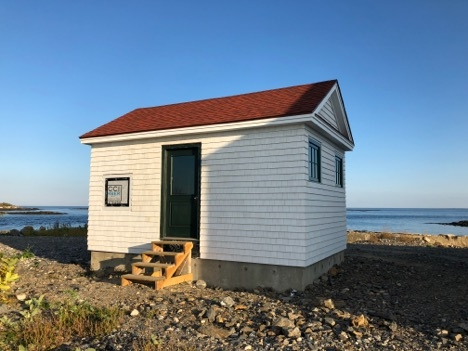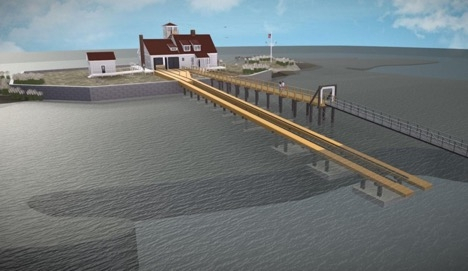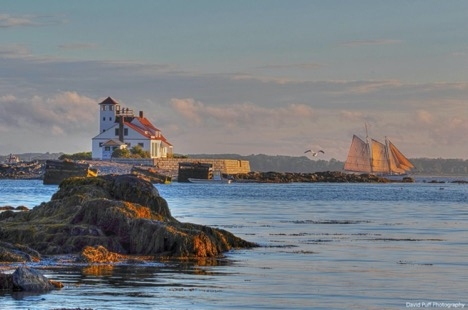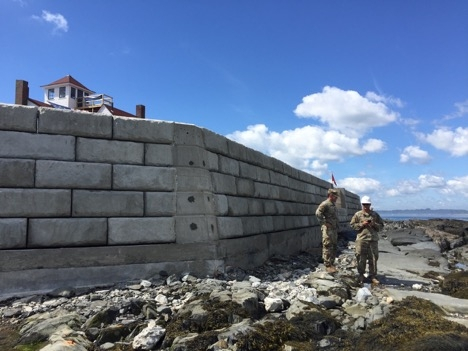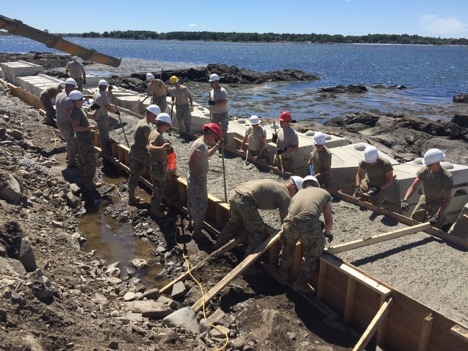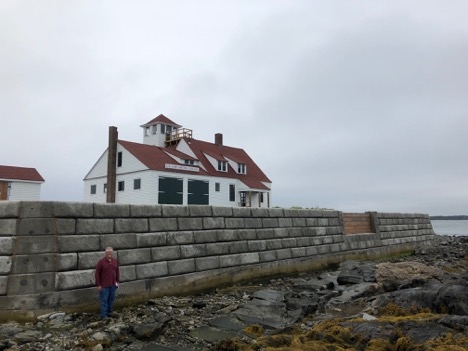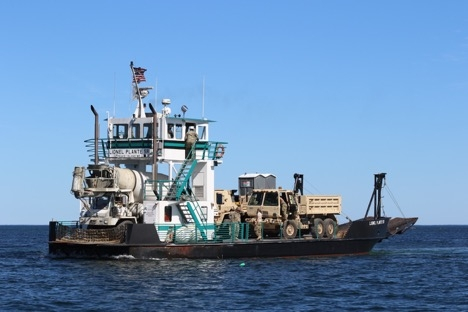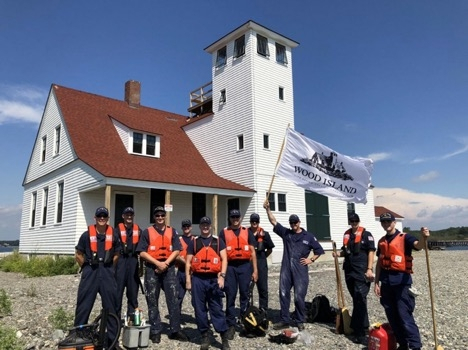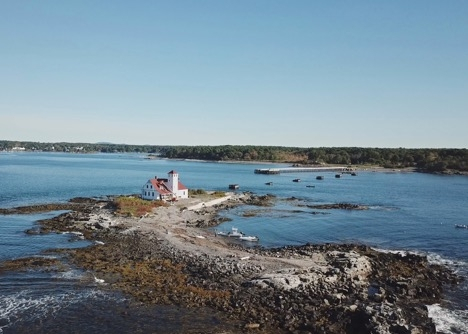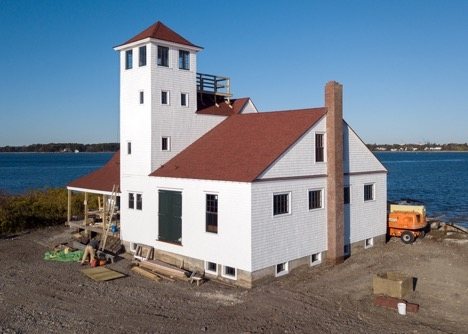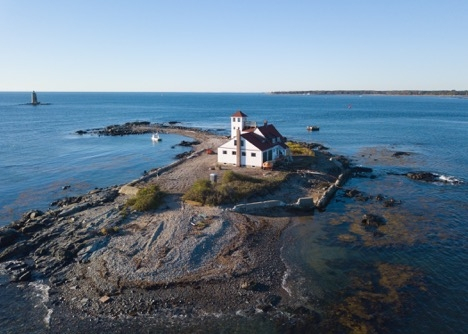The Wood Island Station was erected in 1908 on Wood Island in Kittery Point, Maine. Its location is a dramatic and vulnerable one-acre island at the entrance of the Piscataqua River where it meets the Atlantic Ocean. It replaced an existing 1888 station, the Jerry’s Point Station, across the river in New Castle, New Hampshire. The building is a modified Duluth-type station, designed by architect George R. Tolman and built by Sudgen Brothers of Portsmouth, NH. It remained active until 1948, when it was replaced by a new US Coast Guard station, back again in New Castle, called Station Portsmouth Harbor that remains active to this day.
During the Second World War (1941 – 1945) its life saving duties were put on hold as Wood Island Station helped protect Portsmouth Harbor and its submarine manufacturing base from Nazi submarines. This Station was occupied by the US Navy and was part of an extensive network of harbor defenses that included mines, sonar and a massive metal mesh netting that extended from both shores of the Piscataqua River to Wood Island and closed the entire entrance from the river’s surface to its bottom. During its 40 years of service as many as 66 major rescues were undertaken with hundreds of people saved. The conditions near Wood Island are challenging as the Piscataqua River has one of the strongest currents in a navigable river in the USA (4 knots) with a tidal range typical of the Maine coast of approximately 10 feet.
The island was declared surplus in 1955 but remained part of the US Department of Transportation until the early 1970s when it was transferred to the Dept. of the Interior / National Park Service. In 1973 it was transferred to the Town of Kittery, on the condition that the Town would maintain the island and keep it open to the public as a park. Unfortunately, the Town lacked the resources to adequately maintain the life-saving station and it was allowed to deteriorate until it became dangerous to island visitors.
Kittery’s Town Council appointed a Wood Island Advisory Committee (WIAC) to review the problem and in 2008, a comprehensive analysis of the site was conducted by University of New Hampshire students. The following year, their Wood Island Feasibility Study was presented. Soon thereafter WIAC recommended to Council the total demolition of the Station building. Fortunately, WIAC did not understand the cost to Kittery of that demolition would be approximately $250,000, as State law required the building to be cleaned of asbestos before being torn down. This allowed more time for discussion about preservation. Then the Town, in the fall of 2011, requested proposals from interested non-profits to restore the Station at no cost to Kittery in exchange for a long-term concession agreement to run the restored Station for the benefit of the public.
Only one non-profit submitted a proposal to save the Wood Island Station. The Wood Island Life-Saving Station Association (WILSSA) was formed to respond to the Town’s request for proposals and offered to raise the funds, secure the permits, and organize the restoration work of the Station and the grounds to be opened to the public as a maritime museum celebrating the history of the “surfmen” that served there. Kittery subsequently selected WILSSA. WILSSA offered to maintain the Station and island at no cost to the town of Kittery. WILSSA subsequently obtained 501(c)(3) federal tax-exempt status. The Station was listed by Maine Preservation as one of the “Most Endangered Places in Maine” in 2012.
The Town of Kittery, WIAC and WILSSA had discussions, often heated, about the status of the Station and island for the next two years. Contracts were needed between the parties and progress was slow. WIAC broke off those talks in March of 2013 and again recommended demolition to Town Council. WILSSA responded with two petitions signed by more than 800 Kittery residents that called for a vote of the people of the Town on the question of demolition. The Town Council declared the petitions illegal in July and refused to hold a Town wide vote. Thankfully Council did not move forward with any plans to demolish the Station.
The Council, however, did not miss the clear message that the petitions had delivered and a compromise was reached on October 16, 2013 when a contract between WILSSA and Kittery was approved by a vote of 5 – 1. This contract provided a compromise where WILSSA would restore only the exterior of the building and the grounds of the Wood Island Life-Saving Station. The many issues related to the use after restoration had been the primary impediment to progress so they were put aside with the understanding that if and when WILSSA secured permits and funding those issue would be addressed.
As part of the 2013 agreement, the Town agreed to apply for a $200,000 Brownfields grant from the Environmental Protection Agency to perform the hazardous material cleanup. Significant asbestos, toxic bird guano, lead paint and mold were found throughout the Station. Underground fuel tanks were on the island as well. That grant application was prepared entirely by WILSSA and was submitted on January 22, 2014. The USLSS Heritage Association led an impressive list of supporters for that grant from local, state and national historic preservation groups to the entire Maine congressional delegation and Governor. The grant was awarded on May 28, 2014.
In the summer of 2014, WILSSA transported 4,000 pounds of materials to Wood Island to create scaffolding inside the building to hold up the boat room roof that was failing. A “Flotilla” was also hosted welcoming recreational boaters to parade out to Wood Island and back to show support for the restoration of the Station. This occurred on a lovely August afternoon and more than 30 boats and 200 people participated. This year, 2018, marked the fifth annual “Flotilla for Wood Island” and was similarly well attended and fun.
In September of 2014 a grant request was sent to the National Parks Service’s Maritime Heritage program for $200,000 that needed to be matched dollar for dollar. It too had the support of USLSS Heritage Association, the Maine congressional delegation, the Governor and many other non-profits. Legislation was filed in January of 2015 with the State of Maine for an additional $200,000 to serve as the match. WILSSA also gathered pledges of $150,000 from private donors. Permitting work for the building and grounds with state and federal agencies was well underway.
April of 2015 was a turning point for the restoration of Wood Island Station. The Maine SHPO approved WILSSA’s application for the building to be eligible for the National Register of Historic Places. Also, the National Park Service announced that Wood Island’s request for $200,000 had been approved. Soon thereafter, in June, the funding from the State of Maine was passed into law by the Maine legislature. Even though that funding was line item vetoed by the Governor, the veto was overridden.
The National Register eligibility would not have happened without the help of Tim Dring, Board Chair of USLSSHA. He traveled to Augusta Maine (in March!) to visit with the SHPO in person and made a compelling argument. Wick York also lent a persuasive hand by phone that day. The local building code was not going to allow the restoration to occur as the work was too extensive, unless the building could be designated as “historic” by the SHPO. Tim and Wick’s efforts to help save Wood Island Station will long be remembered. Tim also provided detailed information about the exact rescue craft that served this station.
With funding and permitting moving forward nicely, WILSSA returned to the Town of Kittery through the summer and fall of 2015 taking the position that the October 2013 contract to allow for the exterior restoration only would no longer suffice. It was time to return to the challenging issues of use after restoration. As the building was now eligible for the National Register, there needed to be close coordination between clean up and restoration of the interior – and that was not allowed in the existing contract. WILSSA demanded a new contract that would allow for the full restoration, exterior and interior, and demanded permission to be able to operate a maritime museum for the enjoyment of the public. What is more, there had been no resolution to the question of long-term maintenance responsibility. WILSSA offered to take care of this rare gem of a building for the term of the new contract. WILSSA’s position was, after all, exactly what Kittery had been seeking back in 2011 in its request for proposals.
Again, there was an extended and unpleasant debate with some of Kittery’s leadership. WILSSA even needed to participate in a formal complaint to Council against one of them. But in the end, the fact that more than $750,000 had been raised showed that WILSSA was ready for the challenge ahead. Kittery’s Council disbanded WIAC in August and later approved new contracts (one for repair and one for museum operation) in a tense vote of 4-3 on January 25, 2016. Those contracts provided WILSSA the right to fully restore the Station under the oversight of the SHPO at no cost to Kittery and operate and maintain a maritime museum for forty years after the restoration was completed. The National Park Service requested some minor changes to those contracts before they also signed off on them.
By April of 2016 contracts had been signed with a hazardous materials clean up firm and a general contractor specializing in historic preservation. USLSSHA’s own Penny Watson had even helped create an inventory of the “historic fabric” inside the building in June of 2015 to inform the scope of work for the clean up and restoration crews. The groundbreaking ceremony for the restoration occurred on June 6, 2016. There is a wonderful video about it on the WILSSA web page. The 90+ year old granddaughter of one of the Station’s builders, Barbara Hauck, unveiled a sign describing all of the Phase One participants.
The progress during the summer of 2016 was exceptional. More than 100 tons of debris and new materials were transported to and from the small island in a 75 foot long Vietnam era US Navy surplus landing craft. All materials on and off the island were transported in dumpsters. After many sills, the boat room roof, and countless other rotten members were removed and lovingly replaced, a new roof was installed. By the end of the work in mid October there were no windows or doors or exterior shingles, only Tyvek paper covered the Station, but its structure was stronger than new and there were no longer any hazardous materials within.
Through the winter of 2016 / 2017 WILSSA continued to raise funds and prepare for Phase Two. An additional $400,000 was secured from private foundations. Another National Park Service Maritime Heritage grant was applied for but was unsuccessful. Windows, doors and shingles were purchased. The summer of 2017 saw the completion of the exterior of the station. The SHPO provided valuable input to the choices of materials and techniques. The new exterior looked fantastic.
The fall and winter of 2017 / 2018 were busy with an application to the Kittery Planning Board to confirm the many elements of the operational contract with the Town. Issues included how to manage the waste-water from visitors, the placement of diesel fuel tanks for the generator, and most challenging of all, confirmation of the museum function and the ability to spend the night in the building that is in a zone that is so close to the water. All of these complex items were managed and WILSSA secured a unanimous approval from the Planning Board on January 11, 2018. The only local permits remaining to be secured were the building permits and with the Planning Board approvals in place, those were expected to be academic. All state and federal approvals were already in hand.
Throughout the excellent milestones of Phases One and Two, planning had been underway for a really remarkable Phase Three in 2018. WILSSA and Kittery applied to the US Department of Defense for Innovative Readiness Training. This is a program for military units from active and reserve forces as well as National Guards nationwide to train and practice their skills while also providing valuable services to non-profits and communities.
The Maine Army National Guard respond to the application from WILSSA to come to Wood Island and restore the massive sea walls, build a shed and a pier and restore the historic marine railway. They would also be available to install the rough electrical and plumbing systems.
For the month of June 2018 for 30 straight days, seven days a week, the men and women of the Maine Army National Guard, 60 of them, came to Wood Island with their expertise and considerable equipment all at no charge. WILSSA had raised an additional $370,000 from foundations and individuals to pay for the materials needed by the Guard and charter an 85 foot long landing craft.
The logistical challenge was huge. The landing craft was critical. The Guard provided six ten-ton dump trucks with drivers and fuel. Those vehicles transported the 400 tons of precast concrete block to be used to rebuild the north sea wall in its historic location. The new design provided an additional two feet in height to address rising sea levels and protect the Station. Those trucks also delivered nearly 600 tons of rock and earth to be placed behind the wall where erosion had removed nearly 1/8th of the island. Two enormous excavators were provided by the Guard and placed on the island to move the blocks, rock and earth. 21 concrete trucks came to Wood Island to deliver their loads (more than 400 tons worth) and create a massive footing for the north wall as well as the foundation for the historic shed that will house the generator, fuel tanks and ADA bathroom for the public. The rough electrical and plumbing systems were all installed as well.
The Guard lived in tents in a nearby park and took on the challenge of restoring Wood Island with great gusto. The capability of 60 men and women working hard with plenty of equipment and materials was amazing. The “mission” was a total success. The Innovative Readiness Training program is intended to present the Guard with challenges to solve and Wood Island certainly delivered plenty. It was far from a normal IRT mission. Maine National Guard Brigadier General Douglas Farnum hosted the Admiral of the USCG First District, Andrew Tiongson, and the US Senator from Maine, Angus King, on July 27 to inspect the Guard’s efforts. The consensus was strong that the armed services of this country can accomplish remarkable things. A few months later the Guard provided WILSSA a detailed accounting of what they believed the value of their manpower and equipment was worth; $623,000. The 2018 work season had totaled more than $1 million.
Plans are well underway for 2019, Phase Four, that will be even larger in scale than 2018. The Guard is expected to return to Wood Island in June and construct the south sea wall, the pier and install most if not all of the utilities. They will also install the wreck pole in its historic location. Significant private funding for Phase Four is in the final stages of being raised.
This partnership between WILSSA and the National Guard is exceptionally creative and rare. Frankly, without the Guard, it would not have been possible to take on the scope of work needed. The north wall, to give a sense of scale, is 265 feet long, five sided, and nearly 14 feet tall and four feet thick. It is made up of 274 precast concrete blocks that are each 3200 pounds. The south wall will be very similar in size. The landing craft was capable of transporting up to three fully loaded ten-ton trucks at once or two loaded concrete trucks at once.
One important challenge was that no local boat ramps were capable of handling the sort of weight load of those trucks. A loaded concrete truck (including the truck itself and the concrete) can weigh 35 tons. The Portsmouth Naval Shipyard, however, did have a boat ramp that was designed for heavy loads. But, obviously, the Navy Yard is a secure facility off limits to the public. But since WILSSA had partnered with the Army National Guard, security was not a concern. With substantial paperwork, many lawyers, and a bit of luck, WILSSA was able to create a formal agreement between the US Navy and the Maine Army National Guard to provide access to the Navy Yard and use of that ramp, for free. What is more, once the concrete is placed in the truck it must be removed within 120 minutes as it is constantly in the process of hardening. The logistical challenges were significant!
Tim Dring visited Wood Island Station for the first time in September of 2018. He was favorably impressed. Additional visits to the nearby USCG station and local wooden boat builders were made by Tim to advance WILSSA’s plans to construct an exact replica of a Beebe McLellan motorized surfboat that will be rated for passengers and fully operational. One of these special boats was delivered to Wood Island in 1910 and another in 1914. Preliminary work to finalize the plans to construct that boat have begun and the tentative schedule to complete the vessel is the summer of 2020. Funds for that undertaking appear to be coming together. Also, the final design of the marine railway for Wood Island is nearing completion. To have a fully operational marine railway and a fully operational Bebbe McLellan motorized surfboat would be unique in the USA.
The last elements that await funding and implementation for Wood Island are the interior finishes (plaster, floors, trim, insulation) and the marine railway. Those are likely to wait until spring / summer of 2020, a final Phase Five, although work continues to accomplish some or all of them in 2019. The exhibits and artifacts to be displayed in the museum itself are also still in the planning stages. The entire restoration (building and site) seems likely to be completed by late summer 2020. That will be, hopefully, just in time to welcome the USLSSHA for their annual meeting in the fall of 2020!
The three major tourist boat operators on the Piscataqua River are thrilled with the restoration progress at Wood Island as they plan to bring their customers, for a price, to enjoy the new museum and the island. The income from these visitors will be the basis for paying for the ongoing maintenance and operation of the station. The station will also be available for rent for private functions. A docents’ program will be in place to welcome overnight guests. WILSSA looks forward to transitioning from the fund raising and construction phases of the restoration of Wood Island Station for the estimated $4.2 million total project cost to the operational phase of this very special museum in a very special place.
As they say, “success has a thousand fathers and failure is an orphan.” This success really has had a thousand fathers, and mothers, and many of them came from the USLSSHA. Many thanks!
Sam Reid, President
Wood Island Life-Saving Station Association

